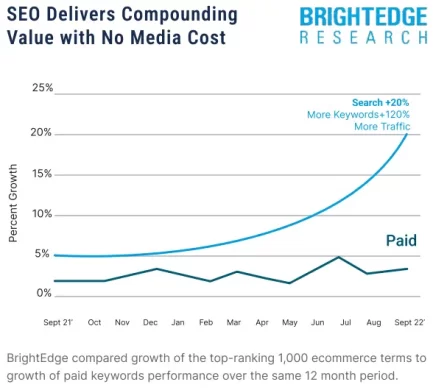
Software as a Service (SaaS) is experiencing rapid growth and is projected to quadruple in the next decade. To stay relevant and competitive in this digital landscape, implementing effective SaaS SEO strategies is more crucial than ever.
SaaS businesses operate predominantly online, relying heavily on digital marketing to connect with their target audience. Having a well-defined SEO blueprint is paramount for the success of SaaS companies.
This comprehensive checklist is derived from proven strategies that have yielded successful results. By following this guide, you can ensure that you cover all essential aspects of SEO optimization for SaaS.
The Significance of SEO for SaaS
Understanding the value of a proven and effective SEO strategy for SaaS is essential before embarking on any initiatives. It's important to note that SEO results may take several months to manifest, but the benefits are long-lasting and impactful.
- Organic Web Traffic Growth: While SEO results may start gradually, they have the potential to increase exponentially over time.
- Enhanced Brand Recognition and Authority: Improved traffic contributes to boosting your domain authority, leading to higher search engine rankings.
- Cost-Effective Customer Acquisition: SEO allows you to acquire new customers at a lower cost compared to paid advertising methods like pay-per-click or social media ads.
- Improved Cross-Channel Conversion: SEO complements other marketing efforts by enabling you to repurpose content and drive traffic across various channels.
- Higher Customer Retention Rates: Establishing authority and awareness through SEO helps in retaining customers and staying top-of-mind.
By focusing on SEO, SaaS companies can overcome common marketing challenges and leverage the growth opportunities presented by the SaaS market.
Essential SEO Checklist for SaaS Companies
Follow these actionable steps to develop and enhance your SEO strategy specifically tailored for SaaS:

Keyword Research Strategy
Content marketing plays a pivotal role in the success of any business, especially in the competitive SaaS landscape. Despite the saturation of content in the market, strategic keyword usage can significantly enhance your brand visibility and competitiveness in search engine results.
SaaS companies can benefit from a pyramid-shaped SEO framework to categorize and prioritize keywords, optimizing marketing opportunities across the conversion funnel.
By aligning content creation with the SEO pyramid framework, SaaS businesses can ensure comprehensive coverage of keywords at different intent levels, maximizing return on investment.
Funnel Marketing Approach
Research indicates that B2B buyers conduct approximately 70% of their brand research before engaging with a company directly. This highlights the importance of creating compelling content to engage potential customers throughout their buying journey.
Mapping your keyword list to the SEO pyramid enables the creation of relevant content for each stage of the buyer's journey, facilitating better customer conversion and sales lead generation.
Identifying content gaps and analyzing customer engagement levels allows for strategic optimization of content strategy to drive better results.

E-A-T Content Strategy
E-A-T, which stands for Expertise, Authoritativeness, and Trustworthiness, are critical factors considered by Google's ranking algorithms, particularly for SaaS companies.
Enhancing your E-A-T score involves showcasing company expertise, incorporating social proof through customer testimonials, and engaging in guest posts and collaborations to establish credibility and authority.
Creating human-centric content that offers real value to users is essential, as search engines prioritize authentic content over AI-generated posts.
Pain-Point Content Creation
Addressing customer pain points is vital for SaaS companies, as it highlights the value proposition of products and services by showcasing solutions to specific challenges or needs.
Emphasizing pain points in your SEO strategy demonstrates empathy and understanding, resonating with potential customers and setting your brand apart in a crowded market.
By aligning with customer needs and concerns, SaaS companies can establish credibility and trust, leading to increased customer engagement and conversions.

Technical SEO Optimization
Prioritizing technical SEO aspects is crucial for achieving robust SEO performance in the SaaS sector. Key focus areas include:
- Google Analytics Integration: Utilize Google Analytics to monitor site performance and identify technical issues.
- Optimized Site Structure: Design an intuitive site structure for seamless user experience and search engine crawling.
- Secure Protocols: Ensure HTTPS implementation by default for enhanced website security.
- Mobile Optimization: Optimize your site for mobile-first indexing to cater to the growing mobile user base.
Conducting a technical SEO audit is essential to streamline and enhance the backend performance of your website, impacting your search engine rankings significantly.
On-Page SEO Best Practices
Implementing on-page SEO optimizations enhances content readability and search engine appeal. Key strategies include:
- Incorporating Keywords in Titles and Headings
- Crafting Compelling Meta Descriptions
- Optimizing Images with Descriptive Alt Text
- Internal Linking to Relevant Pages
Retrospectively applying these features to older posts can revitalize underperforming pages and drive increased traffic.
Backlink Building Strategies
Backlinks from reputable websites are crucial for SEO success in the SaaS industry, indicating content authority to search engine algorithms. Building backlinks requires patience and a long-term content marketing approach.
Creating valuable, shareable content can naturally attract backlinks, increasing visibility and driving organic traffic to your site.

Refer to insights from SEO experts like Ahrefs for effective backlink acquisition strategies tailored to your SaaS business.
High-Value Lead Generation Tactics
Given that most customers conduct extensive research before engaging with SaaS providers, offering compelling lead magnets can initiate customer relationships early on.
Lead magnets, such as actionable checklists, demo videos, and expert whitepapers, serve as valuable incentives for capturing potential client contact information and nurturing leads.
Integrating lead magnets into your content strategy enhances user engagement and drives conversions, establishing a solid foundation for long-term customer relationships.
Enhance Your SaaS SEO Performance Today
This in-depth checklist encompasses essential strategies to elevate your SEO performance for SaaS companies. While the list may seem extensive, expert assistance is readily available to guide you through the optimization process.
When you are ready to refine your SaaS SEO strategy, explore Marketing Insider Group's Content Builder Services for tailored solutions. Reach out for a complimentary consultation and kickstart your SEO optimization journey today!
The original SEO Checklist for SaaS Companies was originally published by Marketing Insider Group.
Frequently Asked Questions
What are some examples for direct marketing?
Direct Marketing Examples include postcards, brochures, flyers, e-mails, etc.
Direct marketing allows people to reach you at their homes or wherever they happen to be. It's the best way of communicating with customers who have already selected your product/service over another.
It is important to know the type of message that appeals most to your target audience.
The key is to find out what your customer wants and then give it to them.
There are many ways to use direct marketing to promote your business. You could send potential customers catalogs or advertise in local newspaper.
Another option is to create your own mailing list from existing customers. You can easily add new subscribers to your list if you have a good contacts database.
Ask your customers if they would like promotional material. Some companies offer discounts to those who sign up for special offers.
What are some examples in indirect marketing?
There are many indirect marketing strategies that you can use to promote and grow your business. You might launch a social media campaign asking people to post pictures of themselves using your product. This could spread awareness of your brand.
Advertisements in local newspapers could be used to encourage readers to visit your auto repair shop rather than other shops.
Another example is to send coupons to customers via e-mail or place ads on bulletin boards at public locations.
Because it isn't expensive, indirect marketing works well.
It takes time to build trust between people so be patient when you promote your business.
Also, you need to monitor how effective your campaigns perform. Try measuring the number of leads generated from each method.
This will let you know which methods are best for you.
What does marketing have to do with business strategy?
Marketing is an integral part of any business strategy. Marketing is key to every business strategy. And without sales, marketing wouldn't matter. Marketing is essential to any business plan.
However, not everyone is aware of the importance and value of marketing. Marketing is often viewed as just spending money on advertisements. Marketing goes beyond that. Marketing can be described as everything you do that communicates your company's identity or position in the market.
As you consider your business, think of these questions: What image do I want to project? How will my customers see me? How should my world perceive me?
If you can't answer these questions, then you aren't thinking about marketing.
What are 3 examples of internet marketing?
Internet Marketing is a term that encompasses online activities intended to promote products, services, and other related topics. Internet marketing includes email marketing and social media marketing. It also includes search engine optimization (SEO), paid-per-click advertising, PPC, and website design.
These terms don't necessarily mean that you have to spend money in order to make money. There are many ways to make income without spending money. The better the return on your investment in each method, however, is the greater the potential for income.
The most common form of internet marketing is email marketing. This involves sending out emails containing information about your business to potential customers.
Another popular method to advertise is through social media marketing. Facebook, Twitter and LinkedIn are all great platforms for sharing information and interacting with friends and loved ones. These sites also provide businesses with an excellent opportunity to connect with their clients and increase awareness of their products or services.
Search Engine Optimization (SEO), a technique to increase website visibility in search engines, is called Search Engine Optimization. Webmasters can boost their website traffic by increasing the number and quality of backlinks.
Website design is the art of creating a website that is attractive and functional. A website designer creates the layout and style of a website. Website designers also ensure accessibility standards are met and that technical specifications are adhered to.
Advertising known as Pay Per Click (PPC), is where advertisers place bids on keywords that relate to their products or services. Advertisers earn a commission when someone clicks their ad. PPC ads are usually found at the top and bottom of search results pages.
Are there risks involved in digital marketing
Yes, digital advertising is fraught with dangers.
You must first protect your online reputation through being cautious about what you share on social media.
You must also ensure that your content is original and doesn't infringe upon any other intellectual property rights.
You also risk losing control over your brand image if your online presence is not monitored closely.
Last but not least, identity theft may occur if someone uses your personal details without you being present.
How to Protect Your Online Reputation:
- Take Care of What You Share on Social Networks
- Ensure that All Content Is Original, and Doesn't Infringe upon Any Other Intellectual Property Rights
- Monitor Brand Image
- Strong passwords are important
- Don't share personal details without authorisation
- Report any unauthorized activity immediately
- Don't Post Photos Of Yourself Or Others In A Disturbing Way
- Never divulge your Social Security Number
- Keep Up With The Latest News
- Avoid Scams
- Secure Password
- Always Keep an Eye out for Updates
- Don't give away too much information
- Take care when you give credit card numbers
- Do Not Send Money Through E-Mail
- Fake websites to avoid
- Bad reviews can be a big problem for your business
- Regularly Check Your Credit Reports
- You Need to Keep an Eye on Your Privacy Settings
- Ask someone who is familiar with you before sharing your thoughts.
Statistics
- This allows us to deliver CPCs that are 80% less than average and CTRs 4-5 times higher than average. (marketinginsidergroup.com)
- A poll earlier this year found that 14% of older Gen Z's had bought an item in the previous six months based on an influencer's recommendation. (influencermarketinghub.com)
- According to statistics, 60% of online shoppers worldwide actively search for coupons before purchasing from a virtual shop. (influencermarketinghub.com)
- From 2020 to 2022, eMarketer predicts that digital marketing will grow by 36% and take up 54% of marketing budgets! (marketinginsidergroup.com)
- In 2017, 34% of marketers cited co-branding as the most effective way to increase the number of email subscribers. (influencermarketinghub.com)
External Links
youtube.com
statista.com
blog.hubspot.com
neilpatel.com
How To
How do I know whether or not my branding efforts are working?
Ask your customers. It is the best way of measuring your success. Ask your customers what they think of your brand. What do they enjoy most about your business? What do they dislike? How can you improve?
Surveys are also possible on social media platforms like Facebook and Twitter. Simply ask your followers to rate you brand by posting a question. Then, you can analyze the results and decide which aspects of brand success are most important.
Also, you can read customer reviews. When people are happy with a business, they love to let their opinion be known. Take the time to read these comments and understand what they think about your brand.
These are some ways to improve your brand.
- Be consistent. You shouldn't update your marketing materials each time you introduce a new product. You should keep your message consistent across all channels.
- You can use multiple channels. To promote your brand, you should use email, social media, websites, and other digital communication channels.
- Give your customers what they want. If you promise free shipping, keep it. You could lose customers who expect easy delivery.
- Remember that your brand is more than just a logo. Your brand is the foundation of everything you do. Make sure you have a balanced image.
- Get feedback from customers. You will be better off if you respond to customers' feedback sooner.
- Test different messages. It is possible that one message performs better than another. You might have two messages that are very similar, but one receives more responses. Whatever the reason, it's important to track your stats to see which message performs best.
- Look for ways to improve your brand. Are there areas you could do things differently? Maybe you could add more videos to your website. Perhaps you could add more customer testimonials to your blog posts.
- Plan. Once you've decided on your goals and objectives, you'll need to develop a strategy for achieving those goals. This includes setting a timeline for each objective. This also includes setting up milestones that will help you track your progress.
- Measuring your results is important. As soon as you reach your goal, stop measuring. Instead, you should set up a system which will allow you to track your progress over time. You'll know whether you are making steady progress towards your ultimate goal.
- Repeat! Continue to build upon the foundation you've created for your brand. You might consider hiring someone to assist you if you have trouble keeping up with current marketing efforts.
- Keep your eyes open for the positive. Negative feedback shouldn't be ignored, but it is not something to dwell on. Instead, focus on the positive aspects of this feedback and how you can make it work for your brand.
- Take advantage of technology. Technology has given us many new tools that we hadn't imagined. These tools are yours to use, so why not take advantage of them? One example is a mobile app you could make for your company.
- Be creative. Try something different. It's okay to try something new, but don't forget to think first.
- Have fun. Marketing isn't supposed to be stressful. It's often referred to as “fun marketing.” Enjoy your work.
- Know when to quit. When you feel like you've done all you can, it's okay to call it quits. However, don't lose heart too soon. Sometimes you have to persevere until you achieve your goals.
- Don't forget about consistency. Consistency is the key to success. Make sure you have a plan in place for your brand.
- Be patient. It takes time to build your brand. It takes time.
- Keep learning. Marketing is constantly changing. You can stay up to date by reading blogs, or even attending webinars.
- Never stop striving to improve. You can still learn from others even after you have achieved your goal.
- Enjoy the ride. Marketing is fun. Marketing is fun.
————————————————————————————————————————————–
By: 6715
Title: The Ultimate Guide to Optimizing SEO Strategies for SaaS Companies
Sourced From: internetlib.org/the-complete-checklist-of-seo-for-saas-companies/
Published Date: 5/3/2023 6:59:03 PM
